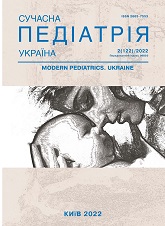The significance of Staphylococcus aureus skin colonization and the yeast Malassezia in children for the development of atopic dermatitis
DOI:
https://doi.org/10.15574/SP.2022.122.39Keywords:
Staphylococcus aureus, Malassezia, atopic dermatitis, childrenAbstract
Patients with atopic dermatitis have a disrupted epidermal barrier, which is one of the prerequisites for the colonization of bacteria and fungi on the affected skin.
Purpose - to investigate the presence of Staphylococcus aureus and Malassezia species skin colonization in patients with atopic dermatitis.
Materials and methods. Skin swabs were taken in 83 patients with atopic dermatitis and 70 healthy children to determine Staphylococcus aureus skin colonization. The level of Malassezia colonization in the samples was determined by polymerase chain reaction.
Results. The affected skin in patients with atopic dermatitis was significantly more often colonized with Staphylococcus aureus than in healthy children (OR=3.974 (1.861-8.486)). SCORAD was significantly higher in Staphylococcus aureus carriers (p<0.05). In the subgroup of Staphylococcus aureus carriers, children were older and the duration of disease was longer (p<0.05). Malassezia restricta and Malassezia globosa were found in 11 patients with atopic dermatitis and 10 healthy children. The prevalence of Malassezia by species depended on sex and the presence of atopic dermatitis.
Conclusions. Staphylococcus aureus skin colonization is significantly more prevalent in children with atopic dermatitis than in healthy people. Malassezia species are common on the skin of both patients with atopic dermatitis and healthy people, but the ratio of species may vary depending on the presence of disease.
The research was carried out in accordance with the principles of the Helsinki declaration. The study protocol was approved by the Local ethics committee of the participating institution. The informed consent of the patient was obtained for conducting the studies.
No conflict of interests was declared by the author.
References
Blicharz L, Michalak M, Szymanek-Majchrzak K, Młynarczyk G, Skowroński K, Rudnicka L, Samochocki Z. (2021). The Propensity to Form Biofilm in vitro by Staphylococcus aureusStrains Isolated from the Anterior Nares of Patients with Atopic Dermatitis: Clinical Associations. Dermatology (Basel, Switzerland). 237 (4): 528-534. https://doi.org/10.1159/000511182; PMid:33113538
Kim J, Kim BE, Ahn K, Leung D. (2019). Interactions Between Atopic Dermatitis and Staphylococcus aureusInfection: Clinical Implications. Allergy, asthma & immunology research. 11 (5): 593-603. https://doi.org/10.4168/aair.2019.11.5.593; PMid:31332972 PMCid:PMC6658404
Nowicka D, Nawrot U. (2019). Contribution of Malassezia spp. to the development of atopic dermatitis. Mycoses. 62 (7): 588-596. https://doi.org/10.1111/myc.12913; PMid:30908750
Park G, Moon BC, Choi G, Lim HS. (2021). Cera Flava Alleviates Atopic Dermatitis by Activating Skin Barrier Function via Immune Regulation. International journal of molecular sciences. 22 (14): 7531. https://doi.org/10.3390/ijms22147531; PMid:34299150 PMCid:PMC8303669
Saad M, Sugita T, Saeed H, Ahmed A. (2013). Molecular epidemiology of Malassezia globosa and Malassezia restricta in Sudanese patients with pityriasis versicolor. Mycopathologia. 175 (1-2): 69-74. https://doi.org/10.1007/s11046-012-9587-y; PMid:23054329
Sugita T, Suzuki M, Goto S, Nishikawa A, Hiruma M, Yamazaki T, Makimura K. (2010). Quantitative analysis of the cutaneous Malassezia microbiota in 770 healthy Japanese by age and gender using a real-time PCR assay. Medical mycology. 48 (2): 229-233. https://doi.org/10.1080/13693780902977976; PMid:19462267
Tauber M, Balica S, Hsu CY, Jean-Decoster C, Lauze C, Redoules D, Viodé C, Schmitt AM, Serre G, Simon M, Paul CF. (2016). Staphylococcus aureusdensity on lesional and nonlesional skin is strongly associated with disease severity in atopic dermatitis. The Journal of allergy and clinical immunology. 137 (4): 1272-1274.e3. https://doi.org/10.1016/j.jaci.2015.07.052; PMid:26559326
Totté JE, van der Feltz WT, Hennekam M, van Belkum A, van Zuuren EJ, Pasmans SG. (2016). Prevalence and odds of Staphylococcus aureuscarriage in atopic dermatitis: a systematic review and meta-analysis. The British journal of dermatology. 175 (4): 687-695. https://doi.org/10.1111/bjd.14566; PMid:26994362
Volosovets ОP, Beketova GV, Berezenko VS, Mityuryaeva IA, Volosovets TN, Pochinok TV. (2021). Dynamics of morbidity and prevalence of atopic dermatitis in children of Ukraine over the past 20 years: medical and environmental aspects. Pediatriia. Vostochnaia Yevropa. 9 (2): 206-216. https://doi.org/10.34883/PI.2021.9.2.005
Wang V, Boguniewicz J, Boguniewicz M, Ong PY. (2021). The infectious complications of atopic dermatitis. Annals of allergy, asthma & immunology: official publication of the American College of Allergy, Asthma, & Immunology. 126 (1): 3-12. https://doi.org/10.1016/j.anai.2020.08.002; PMid:32771354 PMCid:PMC7411503
Downloads
Published
Issue
Section
License
Copyright (c) 2022 Modern pediatrics. Ukraine

This work is licensed under a Creative Commons Attribution-NonCommercial 4.0 International License.
The policy of the Journal “MODERN PEDIATRICS. UKRAINE” is compatible with the vast majority of funders' of open access and self-archiving policies. The journal provides immediate open access route being convinced that everyone – not only scientists - can benefit from research results, and publishes articles exclusively under open access distribution, with a Creative Commons Attribution-Noncommercial 4.0 international license (СС BY-NC).
Authors transfer the copyright to the Journal “MODERN PEDIATRICS. UKRAINE” when the manuscript is accepted for publication. Authors declare that this manuscript has not been published nor is under simultaneous consideration for publication elsewhere. After publication, the articles become freely available on-line to the public.
Readers have the right to use, distribute, and reproduce articles in any medium, provided the articles and the journal are properly cited.
The use of published materials for commercial purposes is strongly prohibited.

